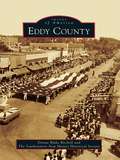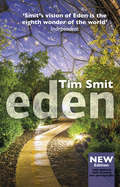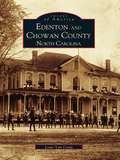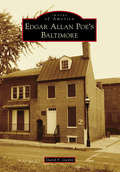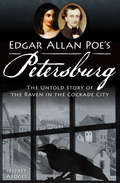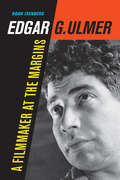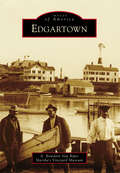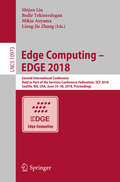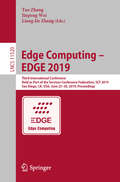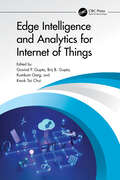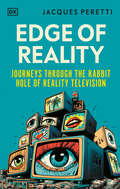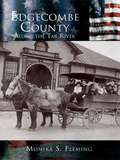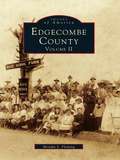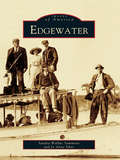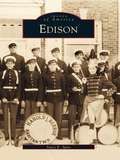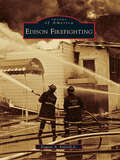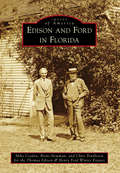- Table View
- List View
Eddie Red Undercover: Mystery on Museum Mile
by Marcos Calo Marcia WellsArt, mystery, fun and friendship, combine in this illustrated middle grade series debut. Sixth grader Edmund Xavier Lonnrot, codename "Eddie Red," has a photographic memory and talent for drawing anything he sees. When the NYPD is stumped by a mastermind art thief, Eddie becomes their secret weapon to solve the case, drawing Eddie deeper into New York's famous Museum Mile and closer to a dangerous criminal group known as The Picasso Gang. With page-turning adventure and fun characters, this first installment in the Eddie Red series is a must-read for any fan of puzzles and mystery.A Spring 2014 Indies Introduce New Voices selection
Eddie the Elephant
by Laura LongEddie the Elephant is a gentle giant. He has big flapping ears to hear even the tiniest of sounds, but that doesn’t stop him from getting scared. The naughty little mice always try to make him jump, and when an elephant jumps, everyone knows! Eddie’s ears and feet are lined with pretty scraps of fabric, and his tail is made from a crocheted chain. Purl ridges make the wrinkles in his trunk.
Eddy County (Images of America)
by Donna Blake Birchell The Southeastern New Mexico Historical SocietyEddy County's 4,198 square miles were carved from the massive land holdings of Lincoln County, then the largest county in the United States, on February 25, 1889. Early Spanish explorers and Native Americans had used the seemingly endless water supply of the Pecos River, which bisects the county, as a trail to the north. Seven Rivers, the first settlement in the Pecos Valley, battled the newly formed town of Eddy for the honor of remaining county seat. Eddy won by a vote of 331 for and 83 against. Although born in lawlessness and diversity, the county flourished as the discoveries of oil, gas, and potash brought industry to support the established fertile agricultural and cattle foundations. This volume explores the early founding families and pioneers and brings to light many of the long-forgotten towns of Dayton, Lookout, Oriental, and Globe that helped form the Eddy County of today.
Eden (Images of America)
by Sue MinekimeFrom its inception, Eden has been a beautiful place to call home. For generations, the fertile soils of Eden have yielded outstanding fresh produce, feeding countless individuals locally and in other states. Before the days of easy travel between places, Eden had thriving retail, commercial, and industrial areas. One business still produces that unique musical instrument, the kazoo, and thanks to inventors from Eden, tractors ride more comfortably and train travel is safer. The town produced a handful of poets, a well-known artist, a concert pianist, five state assemblymen, a state senator, and a chief judge of the State of New York Court of Appeals.
Eden: Updated 15th Anniversary Edition
by Tim Smit'Smit's vision of Eden is the eighth wonder of the world' Independent'Inspiring... An invaluable guide to how a large project can exceed against all odds' The Sunday Times-An updated edition of the bestselling story of the Eden Project featuring stunning new photography.At the beginning of the twenty-first century, the impossible was delivered. From the sterile depths of a disused china clay pit in Cornwall rose one of the most remarkable and ambitious ventures in recent memory. The Eden Project's Biomes, the world's largest conservatories, are the symbol of a living theatre of plants and people and their interdependence, of regeneration and of a pioneering forum for the exploration of possible futures.This is the extraordinary story of the Eden Project, of its conception, design and construction, of the larger-than-life personalities who made it happen and of all that has happened since its doors were first opened to the public in 2001. It is now undisputedly one of the world's great gardens with more than 17 million visitors flocking there and projects and partnerships all over the world.
Edenton and Chowan County, North Carolina (Images of America)
by Louis Van CampConveniently located between three important waterways in Eastern North Carolina, Chowan County, along with its county seat of Edenton, is a remarkable community whose roots dig deeply into the 1600s when settlers arrived from Jamestown. The steadfast Perquimans River to the east, the rapidly flowing Chowan River to the west, and the serene Edenton Bay to the south have for centuries provided means of transportation, economic endeavors, and scenic views for citizens and visitors alike. By 1750, Edenton had blossomed into a distinctly rustic and bustling community, and these water canals had greatly contributed to the needs of the county's merchants, lawyers, carpenters, and plantation workers. Edenton and Chowan County, North Carolina is an engaging pictorial history that celebrates early 20th-century lifestyles enjoyed by community members of the first unofficial colonial capital. Readers will visit ancestral plantations and the ancient labor of seine net fishing, while the Norfolk and Southern railcar-steamship John W. Garrett plies once again across the Albemarle Sound. Many of the area's earlier residents are brought to life, in word and image, while they work at the Edenton Peanut Company, the Edenton Cotton Mill, and many of the old stores that lined Main Street (now Broad Street).
Edgar Allan Poe's Baltimore
by David F. GaylinEdgar Allan Poe wrote his great works while living in several cities on the East Coast of the United States, but Baltimore's claim to him is special. His ancestors settled in the burgeoning town on the Chesapeake during the 18th century, and it was in Baltimore that he found refuge when his foster family in Virginia shut him out. Most importantly, it was here that he was first paid for his literary work. If Baltimore discovered Poe, it also has the inglorious honor of being the place that destroyed him. On October 7, 1849, he died in this city, then known as "Mob Town." Edgar Allan Poe's Baltimore is the first book to explore the poet's life in this port city and in the quaint little house on Amity Street, where he once wrote.
Edgar Allan Poe's Petersburg: The Untold Story of the Raven in the Cockade City
by Jeffrey AbugelVisit the Virginia city where the great author brought his thirteen-year-old bride for a honeymoon. Antebellum Petersburg was a melting pot of French, Haitian, Scotch-Irish, and free black populations. It was in this eclectic city that the master of the macabre, Edgar Allan Poe, chose to take his new wife, thirteen-year-old first cousin Virginia Clemm, on their honeymoon in 1836. This book traces the steps of the controversial couple through imaginative scenes of historic Petersburg. From Poe&’s own mother performing in the local venues to the poet&’s lasting friendship with Petersburg native and publisher Hiram Haines, it reveals an overlooked moment in the young life of this literary giant. Includes photos
Edgar Degas: Paintings That Dance (Smart About Art)
by Maryann Cocca-LefflerEdgar Degas is famous for his paintings of ballerinas, and that's what first attracts Kristin to his artwork. But as she studies him for her report, she discovers that his art ranged far beyond the ballet and she gradually learns exactly what makes Degas's work so unique.
Edgar G. Ulmer: A Filmmaker at the Margins (Weimar and Now: German Cultural Criticism #48)
by Noah IsenbergEdgar G. Ulmer is perhaps best known today for Detour, considered by many to be the epitome of a certain noir style that transcends its B-list origins. But in his lifetime he never achieved the celebrity of his fellow Austrian and German émigré directors—Billy Wilder, Otto Preminger, Fred Zinnemann, and Robert Siodmak. Despite early work with Max Reinhardt and F. W. Murnau, his auspicious debut with Siodmak on their celebrated Weimar classic People on Sunday, and the success of films like Detour and Ruthless, Ulmer spent most of his career as an itinerant filmmaker earning modest paychecks for films that have either been overlooked or forgotten. In this fascinating and well-researched account of a career spent on the margins of Hollywood, Noah Isenberg provides the little-known details of Ulmer’s personal life and a thorough analysis of his wide-ranging, eclectic films—features aimed at minority audiences, horror and sci-fi flicks, genre pictures made in the U.S. and abroad. Isenberg shows that Ulmer’s unconventional path was in many ways more typical than that of his more famous colleagues. As he follows the twists and turns of Ulmer’s fortunes, Isenberg also conveys a new understanding of low-budget filmmaking in the studio era and beyond.
Edgar Heap of Birds
by Bill AnthesFor over three decades, contemporary Native American artist Hock E Aye Vi Edgar Heap of Birds has pursued a disciplined practice in multiple media, having shown his paintings, drawings, prints, and text-based conceptual art throughout numerous national and international galleries and public spaces. In the first book-length study of this important artist, Bill Anthes analyzes Heap of Birds's art and politics in relation to the international contemporary art scene, Native American history, and settler colonialism. Foregrounding how Heap of Birds roots his practice in Cheyenne spirituality and an indigenous way of seeing and being in the world, Anthes describes how Heap of Birds likens his art to "sharp rocks"--weapons delivering trenchant critiques of the loss of land, life, and autonomy endured by Native Americans. Whether appearing as interventions in public spaces or in a gallery, Heap of Birds's carefully honed artworks pose questions about time, modernity, identity, power, and the meaning and value of contemporary art in a global culture.
Edgartown (Images of America)
by A. Bowdoin Riper Martha’s Vineyard MuseumFounded in 1642 as Great Harbor, Edgartown is the oldest of Martha's Vineyard's six townships. It has been a shire town and a center of learning, a whaling port and a fishing village, a manufacturing center and a mecca for sportsmen. Its gleaming captain's houses and majestic public buildings are a testament to the wealth that whaling brought to the island in the mid-1800s, but the end of New England whaling was far from the end of its story. Faced with the loss of the industry that had sustained it, Edgartown reinvented itself as a summer-centered community of resort hotels, bathing beaches, and genteel vacation homes. It welcomed the world to its shores and became an unlikely cultural icon--a backdrop to a best-selling memoir, a political scandal, and a blockbuster film--famous for being its inimitable self.
Edge Computing – EDGE 2018: Second International Conference, Held as Part of the Services Conference Federation, SCF 2018, Seattle, WA, USA, June 25-30, 2018, Proceedings (Lecture Notes in Computer Science #10973)
by Bedir Tekinerdogan Liang-Jie Zhang Shijun Liu Mikio AoyamaThis book constitutes the proceedings of the International Conference on Edge Computing, EDGE 2018, held in Seattle, WA, USA, in June 2018. The 9 full papers and 3 short paper presented in this volume were carefully reviewed and selected from 29 submissions. The contributions are organized in topical sections named: Research Track; Application and Industry Track; and Short Paper Track. They deal with the latest fundamental advances in the state of the art and practice of edge computing.
Edge Computing – EDGE 2019: Third International Conference, Held as Part of the Services Conference Federation, SCF 2019, San Diego, CA, USA, June 25–30, 2019, Proceedings (Lecture Notes in Computer Science #11520)
by Tao Zhang Liang-Jie Zhang Jinpeng WeiThis book constitutes the proceedings of the Third International Conference on Edge Computing, EDGE 2019, held in San Diego, CA, USA, in June 2019. The 5 full papers and 1 short paper presented in this volume were carefully reviewed and selected from 14 submissions. The contributions deal with the latest fundamental advances in the state of the art and practice of edge computing, identifying emerging research topics and defining the future of edge computing.
Edge Intelligence and Analytics for Internet of Things
by Brij B. Gupta Govind P. Gupta Kwok Tai Chui Kumkum GargEdge computing and intelligence is a new technical discipline that researches and develops theories, methods, technologies, and application systems for enabling fast and efficient processing and intelligent decision-making using the big data generated from the Internet of Things (IoT) system. The edge computing and intelligence–enabled IoT system helps in alleviating the resource limitations of IoT devices and facilitates large-scale deployment of IoT systems for different applications such as smart cities, smart grids, smart homes, smart healthcare systems, smart video surveillance, and e-healthcare.Due to the deployment of the IoT devices in the open environment and their interaction with other IoT devices through unstable and unreliable wireless channels, as well as the placement of edge nodes near IoT systems, IoT devices offer many chances for malicious attackers to compromise them through collusion attacks, denial-of-service attacks, and many other types of attacks. Analysis of the network traffic and IoT data at the edge nodes using the latest artificial intelligence techniques will address a number of issues, such as anomaly detection in IoT data, data poisoning attacks, and other security and privacy issues related to IoT systems. In this book, we will provide an overview of the fundamental concepts of edge computing, edge intelligence using advanced machine- and deep-learning models, the architecture of edge computing–based IoT systems, and edge computing–based cyber threat intelligence solutions for IoT systems.
Edge of Reality: Journeys Through the Rabbit Hole of Reality Television
by Jacques PerettiGo behind the scenes of the most shocking, hilarious, controversial genre of entertainment: reality television.Reality TV&’s influence is seismic: twenty-five years ago, the concept didn&’t exist. Yet today, it is one of the most powerful cultural forces on earth; a multi-billion-dollar machine. Despite that, it is often derided as &“trash&”, a cultural McDonalds not worthy of examination. The truth is that reality TV offers a profound insight into who we are as human beings, questioning the very nature of what we deem to be entertaining.Writer, broadcaster, and reality TV-obsessive Jacques Peretti goes behind the scenes of a world that has entranced and consumed him for two decades. Meeting with people at every level of the reality TV machine, from those responsible for coming up with ever-more extreme formats, to the contestants and participants at the heart of some of the most iconic moments in television, who felt that their lives and their vulnerabilities were being exploited in the name of entertainment.This is reality TV as you&’ve never seen it before.
Edgecombe County: Along the Tar River
by Monika S. FlemingEdgecombe County, in the coastal plains of North Carolina along the Tar River, was once home to the Tuscarora tribes and was founded by English immigrants from Virginia. The county swelled as an agricultural center in the cotton and textile industries, bolstered by a wealth of lumber and sustained by a thriving inland river port and railroad. Though the residents struggled through natural, industrial, and economic upheaval, their courage and fortitude endured these hardships and unified their community.
Edgecombe County: Volume II (Images of America)
by Monika S. FlemingEdgecombe County is a unique combination of beautiful pastoral scenery and strong, interestingpeople. Communities like Pinetops, Whitakers, Speed, Leggett, and Conetoe provide an excellent insight into the struggles and triumphs of traditionalAmerican small towns. In this highly anticipatedsecond volume, you will explore the social identity of Edgecombe County by taking visual tours of severalhistoric neighborhoods, schools, and churches. As with any successful region, Edgecombe County's greatest resource is its people, for the area has provided a wealth of talented citizens to the political arena, military battlefronts, the playing fields of professional sports, and the artistic community. This collection of images also honors the countless men and women who persevered through the county's periods of war, depression, and natural disaster and continued to support one another in times of need and adversity.
Edges of Noir: Extreme Filmmaking in the 1960s
by Michael MirabileEdges of Noir challenges the notion that noir film nearly vanished after 1958 until its subsequent “neo-noir” revival between 1973 and 1981. The 1960s, regardless of critical neglect, include some of the most provocative films of the post-World War II decades. Often formally disruptive and experimental, films including Shock Corridor (1963), Mirage (1965), The 3rd Voice (1960), and Point Blank (1967) evoke controversial issues of the era, deriving dynamic influences amongst exploitation cinema, sensationalistic American B movies, and the European New Wave movement. Whether the focus is on nuclear destruction, mind control, or surveillance, late noir films, above all else, vividly portray the collective fears from the time.
Edgewater (Images of America)
by Sandra Wallus Sammons Jo Anne Sikes"Do you want a beautiful winter home in Florida? Located on the highest, driest, healthiest, and most beautiful spot for a town . . ." This land company advertisement is like many we see today in Florida, but it was written over 100 years ago by the founder of Hawks Park, Dr. John Milton Hawks. Hawks Park was established in 1871, and within 15 years, it had 115 permanent residents and was a popular place for many Northerners to enjoy the warm winters along the edge of the beautiful Indian River. By 1925, the growing community became a town and adopted the more descriptive name of Edgewater. While there are more than 20,000 residents in 2005, the population of the city still swells during the winter when people follow the migrating birds and boats, seeking refuge from the snow. Although much has changed since the founding of Edgewater, rare vintage photographs will take the readers through the town's years of growth in this illustrative history.
Edible Plants: A Photographic Survey of the Wild Edible Botanicals of North America
by Jimmy FikeFor over a decade, artist Jimmy Fike traveled across the continental United States in an epic effort to photograph wild edible flora. Edible Plants is the culmination of that journey, featuring over 100 photographs that Fike has selectively colorized to highlight the comestible part of the plant. While the images initially appear to be scientific illustrations or photograms from the dawn of photography when plants were placed directly on sensitized paper and exposed under the sun, a closer look reveals, according to Liesl Bradner of the Los Angeles Times, "haunting [and] eerily beautiful" photographs. Beyond instilling wonder, Fike's contemporary, place-based approach to landscape photography emphasizes our relationship to the natural world, reveals food sources, and encourages environmental stewardship. His clever and beautiful method makes it easy to identify both the specimen and its edible parts and includes detailed descriptions about the plant's wider purposes as food and medicine.Sumptuously illustrated and delightfully informative, Edible Plants is the perfect gift for anyone curious about unlocking the secrets of native North American plants.
Edie: American Girl
by Jean SteinThe “exceptionally seductive biography” of the 1960s icon as told by those who knew her (Los Angeles Times Book Review).In the 1960s, actress and model Edie Sedgwick exploded into the public eye like a comet. She seemed to have it all: she was aristocratic and glamorous, vivacious and young, Andy Warhol’s superstar. But within a few years she flared out as quickly as she had appeared, and before she turned twenty-nine she was dead from a drug overdose.In a dazzling tapestry of voices—family, friends, lovers, rivals—the entire meteoric trajectory of Edie Sedgwick’s life is brilliantly captured. And so is the Pop Art world of the ‘60s: the sex, drugs, fashion, music—the mad rush for pleasure and fame. All glitter and flash on the outside, it was hollow and desperate within—like Edie herself, and like her mentor, Andy Warhol. Alternately mesmerizing, tragic, and horrifying, this book shatters many myths about the ‘60s experience in America.“This is the book of the Sixties that we have been waiting for.” —Norman Mailer
Edison
by Stacy E. SpiesEdison, named for its most famous resident, inventor Thomas Alva Edison, can be called the birthplace of modern life as we know it. It was here at his Menlo Park complex that Thomas Edison created the incandescent electric lightbulb and 300 other inventions, providing residents with not only a place of employment but also a source of national pride. Known as Raritan Township until 1954, Edison was a slow-paced agricultural community until the twentieth century, with farms remaining until the 1950s. After World War II, in the country's rush to house returning war veterans, the expansive farmland became desirable real estate . Edison celebrates the township's history from its rural beginnings as a collection of small villages, to the arrival of the automobile culture on the Lincoln Highway and super highway U.S. Route 1, to its coming-of-age as a modern suburban community during the mid-twentieth century. This book combines photographs from the collections of the Metuchen-Edison Historical Society and the National Park Service, with some of the hundreds taken in the early years of the twentieth century by J. Lloyd Grimstead. Edison includes the many villages that make up the township: Oak Tree, Bonhamtown, Piscatawaytown, Stelton, New Durham, Pumptown Corners, New Dover, and Potters.
Edison Firefighting (Images of America)
by Eugene A. Enfield Jr.During the early part of the 20th century, five separate volunteer fire companies independently organized to protect separate sections of Raritan Township, currently known as Edison. The township was divided by fire districts, each containing elected fire commissioners with political and economic power. In 1926, the first career firefighter was hired, and since then, over 250 career firefighters have taken the oath. Edison Firefighting features images, memorabilia, and photographs from the early days of bucket brigades and horse-drawn carriages to current personnel and apparatus. Significant fires, explosions, and rescues that Edison firefighters confronted throughout the years are revealed within this fascinating book.
Edison and Ford in Florida (Images of America)
by Thomas Edison & Henry Ford Winter Estates Chris Pendleton Mike Cosden Brent NewmanProlific inventor Thomas Edison and automobile pioneer Henry Ford shaped the modern world like few others. The lives of these close friends intersected at their winter homes in southwest Florida. Edison first visited the tiny cattle-ranching community of Fort Myers in 1885, building a home and laboratory soon after. There, he wintered with his wife, Mina, and their children, Madeleine, Charles, and Theodore. Ford purchased the adjacent estate in 1916, wintering in the area with his wife, Clara, and son, Edsel. Here in southwest Florida, these famous neighbors relaxed and found time to explore new projects.


